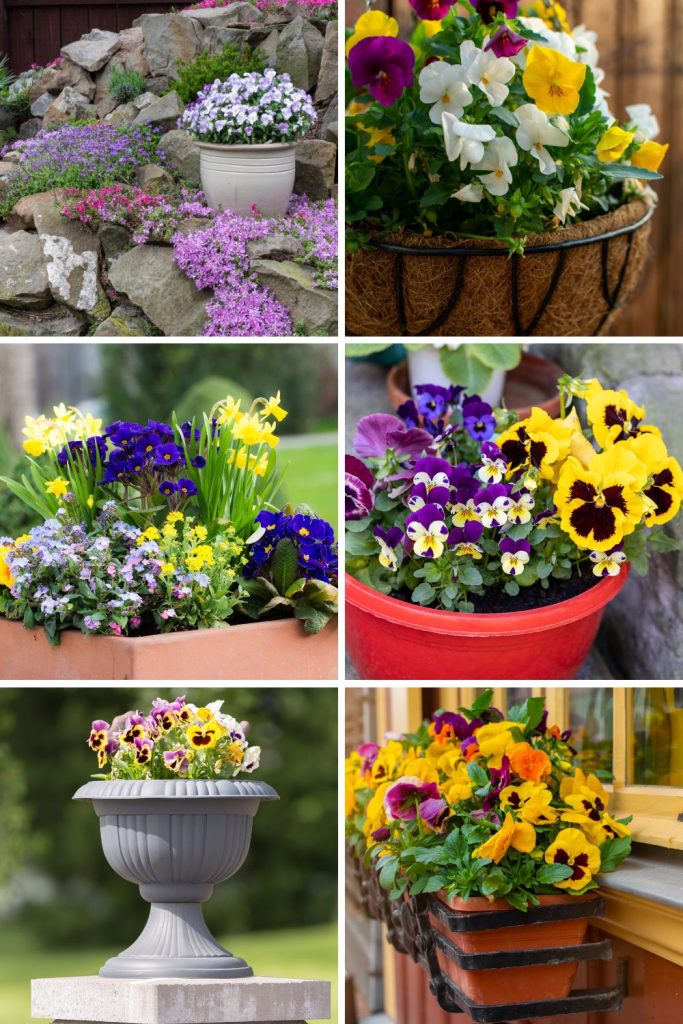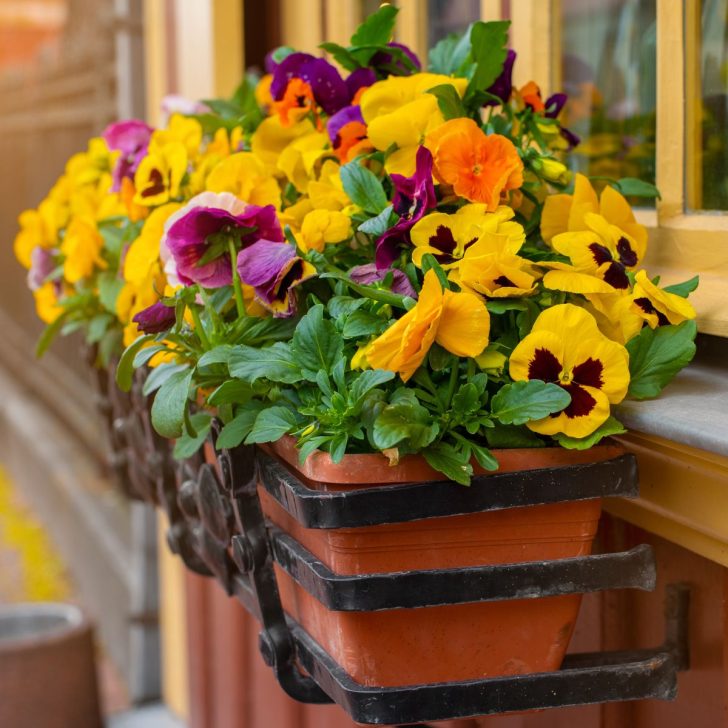Pansies, well known for their vibrant colors and cheerful face-like blossoms, are a favorite among gardeners worldwide. Whether you have a balcony, patio, yard or both, growing pansies in pots adds beauty and versatility to your gardening enjoyment.
Pansies are known for their resilience and ability to add a splash of color, especially in cooler weather. While they can be grown directly in gardens, growing pansies in pots allows for flexibility in positioning and makes it easier to cater to their needs.
If you’re looking to brighten up your balcony, windowsill, or patio, here’s a guide on how to grow and care for pansies in pots.
Pansies are easy-growing, vigorous growers!

Growing Pansies in Pots
When growing pansies in pots, selecting the right container is crucial. Choose a pot with good drainage, as pansies dislike waterlogged soil. The pot should be at least 6-8 inches in diameter, allowing enough room for the roots to grow.
The type of soil used can influence the growth and health of the pansies. Opt for a well-draining potting mix, preferably one with a slow-release fertilizer. If not, you can add a balanced liquid fertilizer every couple of weeks during the growing season.
Planting Pansies in Pots
How to Plant Pansies in Pots from Seeds
- Start Indoors: Pansies are best started indoors about 8-10 weeks before the last expected frost.
- Soil Preparation: Fill pots or seed trays with a good quality seed-starting mix. Moisten the soil lightly.
- Sowing the Seeds: Sow pansy seeds on the surface of the soil and lightly press them in. They need light to germinate, so don’t bury them deep.
- Provide Light and Warmth: Place the pots in a location that gets bright, indirect light. A temperature range of 65-70°F (18-21°C) is ideal for germination.
- Transplanting: Once the seedlings have at least two true leaves, they can be transplanted into individual pots or directly into larger pots where they will grow to maturity.
Planting Pansy Transplants in Pots
- Select Healthy Transplants: Look for pansies with bright, clear colors and green foliage.
- Pot Preparation: Ensure the pot has drainage holes. Fill it partially with potting soil.
- Planting: Dig a hole slightly larger than the root ball of the pansy transplant. Place the plant in, making sure it’s at the same depth it was in its previous container.
- Watering: After planting, water the pansy well, ensuring the soil is moist but not waterlogged.
How to Care for Pansies in Pots
How to Deadhead Pansies in Pots
Deadheading is the process of removing faded or spent blooms to encourage new flowers to grow.
- Identify Spent Flowers: These are flowers that look wilted, faded, or dried up.
- Pinch or Cut: Using your fingers or a pair of sharp scissors, pinch or cut off the flower just below the base of the bloom.
- Regular Checks: Check the pansies every few days for spent flowers to keep them looking their best and encourage prolonged blooming.
The Benefits of Deadheading Go Beyond Beauty
When you pinch or deadhead pansies just below the base of the bloom, it encourages the plant to divert its energy from seed production to flower production. Here’s what happens:
- More Flowers: By removing the spent blooms, you’re preventing the plant from forming seeds. This prompts the plant to produce more flowers in an attempt to generate seeds. The energy that would have gone into seed production is now redirected towards creating new blooms.
- Bushier Growth: Regular deadheading can also promote a bushier growth habit. While pansies don’t necessarily branch out into two flower stems from one base every time you pinch them, the practice does often stimulate new growth lower down on the plant. Over time, this can result in a denser, more compact appearance with more flowering sites.
In essence, the act of deadheading not only maintains a neat appearance but also encourages the plant to produce more blooms and can lead to a fuller growth habit.
Pruning Pansies in Pots
- Identify Leggy Growth: Over time, pansies can become “leggy”, meaning they have long stems with few flowers.
- Cutting Back: Using sharp scissors or pruning shears, cut back the leggy stems by about one-third to one-half.
- Frequency: Prune as needed throughout the growing season to maintain a bushy and compact appearance.
Can Pansies Grow Indoors?
Growing pansies indoors can be a bit challenging, primarily because they are cool-season plants that thrive best in outdoor conditions with plenty of sunlight. However, with the right care and conditions, it’s possible to grow pansies indoors. Here’s what you need to know:
- Light: Pansies require a good amount of sunlight to flourish. If you’re growing them indoors, place them near a south-facing window where they can receive at least 6 hours of direct sunlight daily. If natural light is insufficient, consider using grow lights.
- Temperature: Pansies prefer cool temperatures. Ideally, they like daytime temperatures around 60°F (15°C) and slightly cooler temperatures at night. Many homes tend to be warmer than this, especially in the winter when the heat is on, so it can be challenging to provide the optimal temperature.
- Watering: Be sure not to overwater your indoor pansies. Allow the top inch of soil to dry out between waterings. Ensure the pot has good drainage to avoid waterlogged conditions, which can lead to root rot.
- Humidity: Pansies don’t have specific humidity requirements, but it’s essential to ensure they’re not in a location where the air is too dry. If the air in your home tends to be dry, especially during winter, consider placing a tray filled with water and pebbles beneath the pot. As the water evaporates, it will increase the humidity around the plant.
- Fertilization: Feed your indoor pansies with a balanced, water-soluble fertilizer every 2-4 weeks. Always follow the manufacturer’s instructions regarding dosage.
- Potential Challenges: Growing pansies indoors can make them more susceptible to pests like aphids and spider mites. Regularly inspect your plants and treat any infestations promptly.
You may also benefit from this article on What Temperature Will Kill Pansies. This is especially important when growing pansies in pots where they have less insulation from temperature fluctuations.
Pansies in Pots Ideas
- Mixed Colors: Mix and match various pansy colors in a single pot for a vibrant display.
- Layering: Layer pansies with other cool-season flowers like violas or snapdragons for a varied look.
- Hanging Baskets: Pansies in hanging baskets can make for a delightful vertical display.
- Theme Gardens: Consider a monochromatic theme or a pastel theme using pansies of specific color shades.
Growing pansies in pots is a fulfilling gardening experience, and with the right care, they will reward you with a long-lasting burst of color. Whether you’re a seasoned gardener or a beginner, pansies in pots are sure to bring joy to your space.
Did you know that pansies are edible? Not only that but they also add beauty and beneficial nutrients!

You may also enjoy this article on when to plant pansies, or discover if pansies are perennials. You may also enjoy perusing pots and pansies on Amazon.
I’m LeAura Alderson, a garden, herb and plant enthusiast with a passion for discovering the many edible and medicinal benefits of the plants all around us, including the weeds! I’m a writer, editor and media publisher for our family of websites.
While I was certified in fitness and life coaching, I am NOT a health practitioner. However, I’m a lifelong health enthusiast, with a keen interest in healthy, organic foods and making home remedies and the content we share is from our own experience and usage as well as that extracted from scientific research so that you can explore further on your own.
Always seek the advice and guidance of your health practitioners first and foremost.
As a family we’re steadily expanding our gardening, experimentation and knowledge around all things gardening, edible landscaping, fresh organic foods and self sustainability with farming in our future. I also own and manage iCreateDaily.com, a site all about transformation through creation, and the power of positivity, optimism and mindset.

